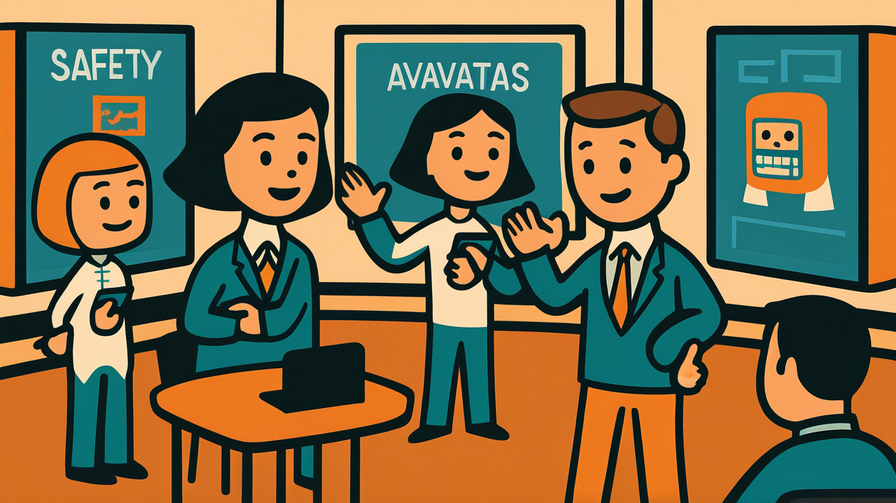[Disclaimer] This article is reconstructed based on information from external sources. Please verify the original source before referring to this content.
News Summary
The following content was published online. A translated summary is presented below. See the source for details.
NVIDIA and Singapore Institute of Technology have developed SynthDa, a revolutionary system that creates synthetic (computer-generated) videos to train AI in recognizing human actions, particularly for safety-critical applications. The technology addresses a major challenge: rare but important actions like falls or accidents are difficult to capture in real-world datasets due to privacy concerns and their infrequent occurrence. SynthDa works by taking real human motions and transferring them to digital avatars in randomized virtual environments, creating thousands of training examples from just a few real samples. The system offers two modes: “Synthetic mix” uses AI-generated sequences, while “Real mix” blends pairs of real-world movements. This approach helps AI systems better recognize minority actions without compromising privacy. Real-world implementations include schools in Singapore using SynthDa to monitor student safety in science labs, identifying equipment misuse or procedural errors. Universities in Japan are exploring its use for bicycle safety and robotics. The modular design allows researchers to customize components for specific needs, making it accessible for various safety monitoring applications while maintaining ethical standards around privacy protection.
Source: NVIDIA Developer Blog
Our Commentary
Background and Context

Imagine you’re teaching a robot to be a lifeguard. To do its job well, it needs to recognize when someone is drowning—but you can’t exactly have people pretend to drown hundreds of times for training videos! That’s the problem SynthDa solves. It creates realistic but fake videos of human actions, especially rare or dangerous ones, to train AI systems.
This is crucial for safety applications where real footage might be impossible, unethical, or illegal to obtain—like recording actual falls in nursing homes or accidents in factories. Instead of waiting for bad things to happen and filming them, SynthDa creates virtual scenarios that look real enough to train AI effectively.
Expert Analysis
SynthDa works through a clever process that’s like advanced motion-capture meets video game technology:
Step 1: Capture Real Motion
First, they record real people doing actions—walking, sitting, reaching. This creates a 3D skeleton of movements, like the wireframe characters you see in behind-the-scenes movie footage.
Step 2: Transfer to Digital Avatars
These movements are then applied to virtual characters (like video game characters) that can be placed in any environment. It’s like having digital stunt doubles who can perform the same action thousands of times in different settings.
Step 3: Mix and Match
The really clever part is how SynthDa creates variations. It can blend two different movements together (like mixing walking and stumbling to create various types of near-falls) or place the same action in different virtual rooms with different lighting and camera angles.
This approach solves three major problems:
• Privacy: No need to film real people in vulnerable situations
• Rarity: Can create thousands of examples of rare events
• Cost: Much cheaper than staging and filming real scenarios
Additional Data and Fact Reinforcement
Real-world applications already showing promise:
Singapore Schools (NIE & Hwa Chong Institution):
• Monitoring science lab safety without filming actual students
• AI learns to spot dangerous equipment use or procedure errors
• Protects student privacy while improving safety
Japanese Universities:
• Shiga University: Creating bicycle safety monitoring systems
• University of Tokyo: Teaching robots through synthetic demonstrations
The numbers are impressive:
• From 1 real action → thousands of synthetic variations
• Different environments, lighting, camera angles
• Works with existing AI training tools like NVIDIA TAO
Related News
This development is part of a broader trend of using synthetic data to train AI ethically. We’ve seen similar approaches in self-driving cars (creating virtual accidents to train safety systems) and medical AI (generating synthetic patient data to protect privacy). The timing is perfect as schools and workplaces increasingly adopt AI monitoring for safety but face pushback over privacy concerns.
The open-source nature of SynthDa is particularly important. Unlike proprietary systems that cost millions, this tool is freely available for researchers and schools. This democratization means even smaller institutions can develop safety monitoring systems tailored to their specific needs without massive budgets or privacy violations.
Summary

SynthDa represents a breakthrough in ethical AI training, using virtual actors in digital worlds to teach AI systems how to recognize and respond to human actions, especially in safety-critical situations. By creating synthetic videos that preserve privacy while providing diverse training data, it enables better safety monitoring in schools, eldercare facilities, and workplaces.
For students interested in AI, robotics, or digital safety, SynthDa shows how creative solutions can address real-world problems. You don’t always need more data—sometimes you need smarter ways to use the data you have. Whether you’re interested in protecting elderly people from falls, making science labs safer, or teaching robots to understand human behavior, tools like SynthDa demonstrate that the future of AI isn’t just about powerful algorithms—it’s about using technology responsibly to help people while respecting their privacy.
Public Reaction
Educators praise the privacy-preserving approach, especially for monitoring students without creating permanent recordings. Safety professionals see huge potential for training systems to spot rare but critical events. Privacy advocates appreciate that synthetic data eliminates the need for invasive surveillance. Some critics worry about AI monitoring in general, though they acknowledge synthetic training is better than real surveillance footage. Students and parents generally support safety monitoring that doesn’t involve actual recordings of children.
Frequently Asked Questions
Q: Can AI really learn from fake videos?
A: Yes! As long as the movements and physics are realistic, AI can learn patterns from synthetic data just as well as real videos. It’s like learning to drive using a realistic simulator.
Q: What happens to the real motion data used as a base?
A: The original recordings are just movement patterns (skeleton data), not actual videos of people. Once converted to digital avatars, the original identity is completely removed.
Q: Could this technology be misused for deepfakes?
A: SynthDa is designed specifically for action recognition training, not creating realistic human faces or voices. The avatars are clearly digital and meant for AI training, not deception.


